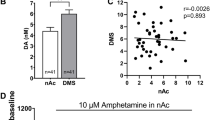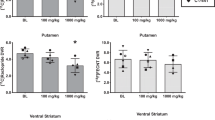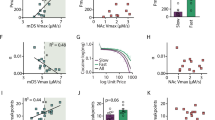Abstract
During recent years, much attention has been devoted at investigating the modulatory role of central 5-HT2C receptors on dopamine (DA) neuron activity, and it has been proposed that these receptors modulate selectively DA exocytosis associated with increased firing of DA neurons. In the present study, using in vivo microdialysis in the nucleus accumbens (NAc) and the striatum of halothane-anesthetized rats, we addressed this hypothesis by assessing the ability of 5-HT2C agents to modulate the increase in DA outflow induced by haloperidol and cocaine, of which the effects on DA outflow are associated or not with an increase in DA neuron firing, respectively. The intraperitoneal administration of cocaine (10–30 mg/kg) induced a dose-dependent increase in DA extracellular levels in the NAc and the striatum. The effect of 15 mg/kg cocaine was potentiated by the mixed 5-HT2C/2B antagonist SB 206553 (5 mg/kg i.p.) and the selective 5-HT2C antagonist SB 242084 (1 mg/kg i.p.) in both brain regions. The mixed 5-HT2C/2B agonist, Ro 60-0175 (1 mg/kg i.p.), failed to affect cocaine-induced DA outflow, but reduced significantly the increase in DA outflow induced by the subcutaneous administration of 0.1 mg/kg haloperidol. The obtained results provide evidence that 5-HT2C receptors exert similar effects in both the NAc and the striatum, and they modulate DA exocytosis also when its increase occurs independently from an increase in DA neuron impulse activity. Furthermore, they show that 5-HT2C agonists, at variance with 5-HT2C antagonists, exert a preferential control on the impulse-stimulated release of DA.
Similar content being viewed by others
Log in or create a free account to read this content
Gain free access to this article, as well as selected content from this journal and more on nature.com
or
References
Bankson MG, Cunningham KA (2002). Pharmacological studies of the acute effects of (+)-3,4-methylenedioxymethamphetamine on locomotor activity: role of 5-HT(1B/1D) and 5-HT(2) receptors. Neuropsychopharmacology 26: 40–52.
Benwell ME, Balfour DJ, Lucchi HM (1993). Influence of tetrodotoxin and calcium on changes in extracellular dopamine levels evoked by systemic nicotine. Psychopharmacology 112: 467–474.
Blackburn TP, Minabe Y, Middlemiss DN, Shirayama Y, Hashimoto K, Ashby Jr CR (2002). Effect of acute and chronic administration of the selective 5-HT2C receptor antagonist SB-243213 on midbrain dopamine neurons in the rat: an in vivo extracellular single cell study. Synapse 46: 129–139.
Bonhomme N, De Deurwaerdère P, Le Moal M, Spampinato U (1995). Evidence for 5-HT4 receptor subtype involvement in the enhancement of striatal dopamine release induced by serotonin: a microdialysis study in the halothane-anesthetized rat. Neuropharmacology 34: 269–279.
Brodie MS, Bunney EB (1996). Serotonin potentiates dopamine inhibition of ventral tegmental area neurons in vitro. J Neurophysiol 76: 2077–2082.
Bubar MJ, McMahon LR, De Deurwaerdère P, Spampinato U, Cunningham KA (2003). Selective serotonin reuptake inhibitors enhance cocaine-induced locomotor activity and dopamine release in the nucleus accumbens. Neuropharmacology 44: 342–353.
Cunningham KA, Lakoski JM (1990). The interaction of cocaine with serotonin dorsal raphe neurons. Single-unit extracellular recording studies. Neuropsychopharmacology 3: 41–50.
De Deurwaerdère P, Chesselet MF (2000). Nigrostriatal lesions alter oral dyskinesia and c-fos expression induced by the serotonin agonist m-CPP in adult rats. J Neurosci 20: 5170–5178.
De Deurwaerdère P, Spampinato U (2001). The nigrostriatal dopamine system: a neglected target for 5-HT2C receptors. Trends Pharmacol Sci 22: 502–504.
De Deurwaerdère P, Stinus L, Spampinato U (1998). Opposite change of in vivo dopamine release in the rat nucleus accumbens and striatum that follows electrical stimulation of dorsal raphe nucleus: role of 5-HT3 receptors. J Neurosci 18: 6528–6538.
Di Chiara G, Imperato A (1988). Drugs abused by humans preferentially increase synaptic dopamine concentrations in the mesolimbic system of freely moving rats. Proc Natl Acad Sci 85: 5274–5278.
Di Giovanni G, De Deurwaerdère P, Di Mascio M, Di Matteo V, Esposito E, Spampinato U (1999). Selective blockade of serotonin-2C/2B receptors enhances mesolimbic and mesostriatal dopaminergic function: a combined in vivo electrophysiological and microdialysis study. Neuroscience 91: 587–597.
Di Giovanni G, Di Matteo V, La Grutta V, Esposito E (2001). m-Chlorophenylpiperazine excites non-dopaminergic neurons in the rat substantia nigra and ventral tegmental area by activating serotonin-2C receptors. Neuroscience 103: 111–116.
Eberle-Wang K, Mikeladze Z, Uryu K, Chesselet MF (1997). Pattern of expression of the serotonin2C receptor messenger RNA in the basal ganglia of adult rats. J Comp Neurol 384: 233–247.
Filip MM, Cunningham KA (2002). Serotonin 5-HT(2C) receptors in nucleus accumbens regulate expression of the hyperlocomotive and discriminative stimulus effects of cocaine. Pharmacol Biochem Behav 71: 745–756.
Filip MM, Cunningham KA (2003). Hyperlocomotive and discriminative stimulus effects of cocaine are under the control of serotonin 5-HT2C receptors in rat prefrontal cortex. J Pharmacol Exp Ther 306: 734–743.
Fletcher PJ, Grottick AJ, Higgins GA (2002). Differential effects of the 5-HT(2A) receptor antagonist M100907 and the 5-HT(2C) receptor antagonist SB242084 on cocaine-induced locomotor activity, cocaine self-administration and cocaine-induced reinstatement of responding. Neuropsychopharmacology 27: 576–586.
Fox SH, Moser B, Brotchie JM (1998). Behavioral effects of 5-HT2C receptor antagonism in the substantia nigra pars reticulata of the 6-hydroxydopamine-lesioned rat model of Parkinson's disease. Exp Neurol 151: 35–49.
Gobert A, Rivet JM, Lejeune F, Newman-Tancredi A, Adhumeau-Auclair A, Nicolas JP et al (2000). Serotonin(2C) receptors tonically suppress the activity of mesocortical dopaminergic and adrenergic, but not serotonergic, pathways: a combined dialysis and electrophysiological analysis in the rat. Synapse 36: 205–221.
Grottick AJ, Corrigall WA, Higgins GA (2001). Activation of 5-HT(2C) receptors reduces the locomotor and rewarding effects of nicotine. Psychopharmacology 157: 292–298.
Grottick AJ, Fletcher PJ, Higgins GA (2000). Studies to investigate the role of 5-HT(2C) receptors on cocaine- and food-maintained behavior. J Pharmacol Exp Ther 295: 1183–1191.
Hutson PH, Barton CL, Jay M, Blurton P, Burkamp F, Clarkson R et al (2000). Activation of mesolimbic dopamine function by phencyclidine is enhanced by 5-HT2C/2B receptor antagonists: neurochemical and behavioural studies. Neuropharmacology 39: 2318–2328.
Jones BJ, Blackburn TP (2002). The medical benefit of 5-HT research. Pharmacol Biochem Behav Apr 71: 555–568.
Kankaanpää A, Meririnne E, Seppala T (2002). 5-HT3 receptor antagonist MDL 72222 attenuates cocaine- and mazindol-, but not methylphenidate-induced neurochemical and behavioral effects in the rat. Psychopharmacology 159: 341–350.
Kennett GA, Wood MD, Bright F, Cilia J, Piper DC, Gager T et al (1996). In vitro and in vivo profile of SB 206553, a potent 5-HT2C/5-HT2B receptor antagonist with anxiolytic-like properties. Br J Pharmacol 117: 427–434.
Kennett GA, Wood MD, Bright F, Trail B, Riley G, Holland V et al (1997). SB 242084, a selective and brain penetrant 5-HT2C receptor antagonist. Neuropharmacology 36: 609–620.
Lucas G, De Deurwaerdère P, Caccia S, Spampinato U (2000). The effect of serotonergic agents on haloperidol-induced striatal dopamine release in vivo: opposite role of 5-HT2A and 5-HT2C receptor subtypes and significance of the haloperidol dose used. Neuropharmacology 39: 1053–1063.
McCreary AC, Cunningham KA (1999). Effects of the 5-HT2C/2B antagonist SB 206553 on hyperactivity induced by cocaine. Neuropsychopharmacology 20: 556–564.
Mereu G, Fanni B, Gessa GL (1984). General anesthetics prevent dopaminergic neuron stimulation by neuroleptics. In: Usdin E, Carlsson A, Dahlstrom A, Engel J (eds). Catecholamines: Neuropharmacology and Central Nervous System—Theoretical Aspects. Alan R Liss Inc.: New York. pp. 353–358.
Müller CP, De Souza Silva MA, DePalma G, Tomaz C, Carey RJ, Huston JP (2002). The selective serotonin(1A)-receptor antagonist WAY 100635 blocks behavioral stimulating effects of cocaine but not ventral striatal dopamine increase. Behav Brain Res 134: 337–346.
Paxinos G, Watson C (1986). The Rat Brain: in Stereotaxic Coordinates. Academic Press: New York.
Pazos A, Cortés R, Palacios JM (1985). Quantitative autoradiographic mapping of serotonin receptors in the rat brain. II. Serotonin-2 receptors. Brain Res 346: 231–249.
Pitts DK, Marwah J (1988). Cocaine and central monoaminergic neurotransmission: a review of electrophysiological studies and comparison to amphetamine and antidepressants. Life Sci 42: 949–968.
Porras G, De Deurwaerdère P, Moison D, Spampinato U (2003). Conditional involvement of striatal serotonin3 receptors in the control of in vivo dopamine outflow in the rat striatum. Eur J Neurosci 17: 771–781.
Porras G, Di Matteo V, De Deurwaerdère P, Esposito E, Spampinato U (2002a). Central serotonin4 receptors selectively regulate the impulse-dependent exocytosis of dopamine in the rat striatum: in vivo studies with morphine, amphetamine and cocaine. Neuropharmacology 43: 1099–1109.
Porras G, Di Matteo V, Fracasso C, Lucas G, De Deurwaerdère P, Caccia S et al (2002b). 5-HT2A and 5-HT2C/2B receptor subtypes modulate dopamine release induced in vivo by amphetamine and morphine in both the rat nucleus accumbens and striatum. Neuropsychopharmacology 26: 311–324.
Pozzi L, Acconcia S, Ceglia I, Invernizzi RW, Samanin R (2002). Stimulation of 5-hydroxytryptamine (5-HT(2C)) receptors in the ventrotegmental area inhibits stress-induced but not basal dopamine release in the rat prefrontal cortex. J Neurochem 82: 93–100.
Rocha BA, Goulding EH, O'Dell LE, Mead AN, Coufal NG, Parsons LH et al (2002). Enhanced locomotor, reinforcing, and neurochemical effects of cocaine in serotonin 5-hydroxytryptamine 2C receptor mutant mice. J Neurosci 22: 10039–10045.
Svenningsson P, Tzavara ET, Liu F, Fienberg AA, Nomikos GG, Greengard P (2002). DARPP-32 mediates serotonergic neurotransmission in the forebrain. Proc Natl Acad Sci USA 99: 3188–3193.
Teneud LM, Baptista T, Murzi E, Hoebel BG, Hernandez L (1996). Systemic and local cocaine increase extracellular serotonin in the nucleus accumbens. Pharmacol Biochem Behav 53: 747–752.
Tomkins DM, Joharchi N, Tampakeras M, Martin JR, Wichmann J, Higgins GA (2002). An investigation of the role of 5-HT(2C) receptors in modifying ethanol self-administration behaviour. Pharmacol Biochem Behav 71: 735–744.
Westerink BHC, Hofsteede RM, Tuntler J, De Vries JB (1989). Use of calcium antagonism for the characterization of drug-evoked dopamine release from the brain of conscious rats determined by microdialysis. J Neurochem 52: 722–729.
White FJ (1990). Electrophysiological basis of the reinforcing effects of cocaine. Behav Pharmacol 1: 303–315.
Willins DL, Meltzer HY (1998). Serotonin 5-HT2C agonists selectively inhibit morphine-induced dopamine efflux in the nucleus accumbens. Brain Res 781: 291–299.
Wood MD, Heidbreder C, Reavill C, Ashby Jr CR, Middlemiss DN (2001). 5-HT2C receptor antagonists: potential in schizophrenia. Drug Dev Res 54: 88–94.
Zachariou V, Benoit-Marand M, Allen PB, Ingrassia P, Fienberg AA, Gonon F et al (2002). Reduction of cocaine place preference in mice lacking the protein phosphatase 1 inhibitors DARPP 32 or Inhibitor 1. Biol Psychiatry 51: 612–620.
Acknowledgements
This work was supported by grants from Centre National de la Recherche Scientifique and Bordeaux 2 University. S Navailles was a fellowship recipient from the Ministère de la Recherche et de l'Enseignement Supérieur during the course of this study. We are grateful to Dr M Wood (Psychiatry CEDD, GlaxoSmithKline, Harlow, UK) for the generous gift of SB 206553 and SB 242084 and Dr P Weber (F Hoffmann-La Roche, Basel, Switzerland) for the gift of Ro 60-0175. We thank D Moison for the technical assistance.
Author information
Authors and Affiliations
Corresponding author
Rights and permissions
About this article
Cite this article
Navailles, S., De Deurwaerdère, P., Porras, G. et al. In Vivo Evidence that 5-HT2C Receptor Antagonist but not Agonist Modulates Cocaine-Induced Dopamine Outflow in the Rat Nucleus Accumbens and Striatum. Neuropsychopharmacol 29, 319–326 (2004). https://doi.org/10.1038/sj.npp.1300329
Received:
Revised:
Accepted:
Published:
Issue date:
DOI: https://doi.org/10.1038/sj.npp.1300329
Keywords
This article is cited by
-
5-HT2C Agonists Modulate Schizophrenia-Like Behaviors in Mice
Neuropsychopharmacology (2017)
-
Effects of 5-HT1A, 5-HT2A and 5-HT2C receptor agonists and antagonists on responding for a conditioned reinforcer and its enhancement by methylphenidate
Psychopharmacology (2017)
-
A short history of the 5-HT2C receptor: from the choroid plexus to depression, obesity and addiction treatment
Psychopharmacology (2017)
-
The role of serotonin in memory: interactions with neurotransmitters and downstream signaling
Experimental Brain Research (2014)
-
Multiple controls exerted by 5-HT2C receptors upon basal ganglia function: from physiology to pathophysiology
Experimental Brain Research (2013)



